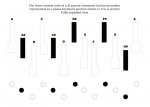D
Daddy Long Les
Guest
These three diagrams (attached) may help de-mystify the way that a CBA (B system) compares to a standard keyboard.
I've only shown one octave and the three outside rows. Again, this would have helped me to understand the layout as a complete beginner so hopefully it may be of interest to others out there.
I've only shown one octave and the three outside rows. Again, this would have helped me to understand the layout as a complete beginner so hopefully it may be of interest to others out there.



